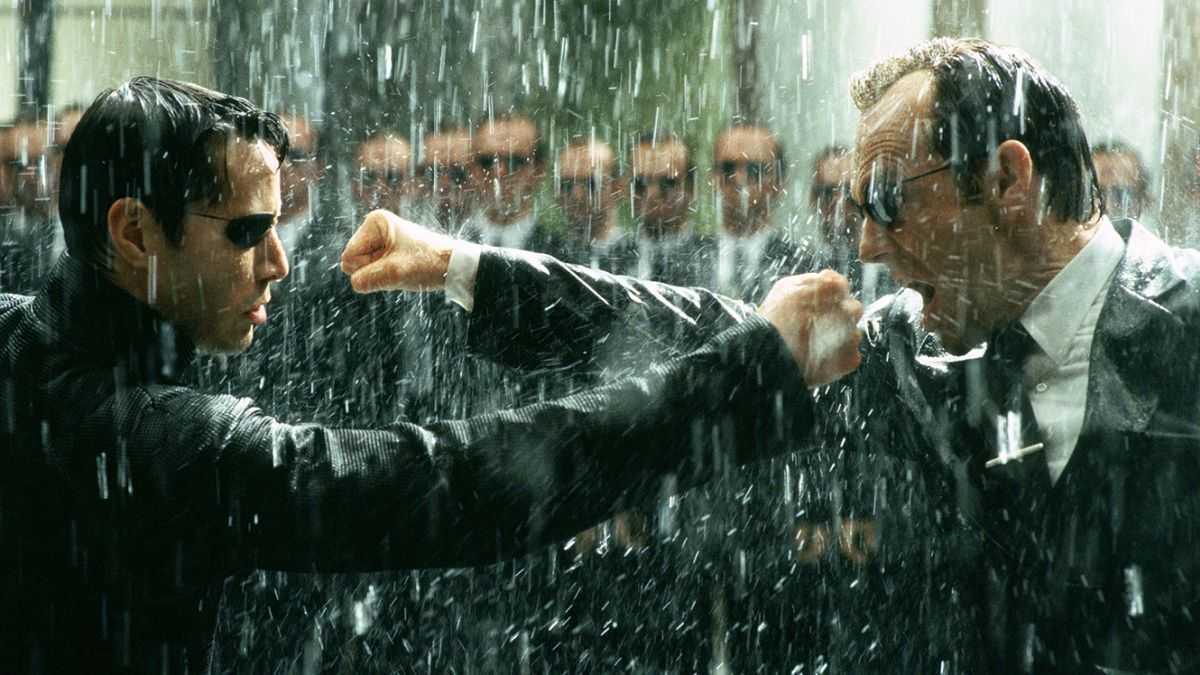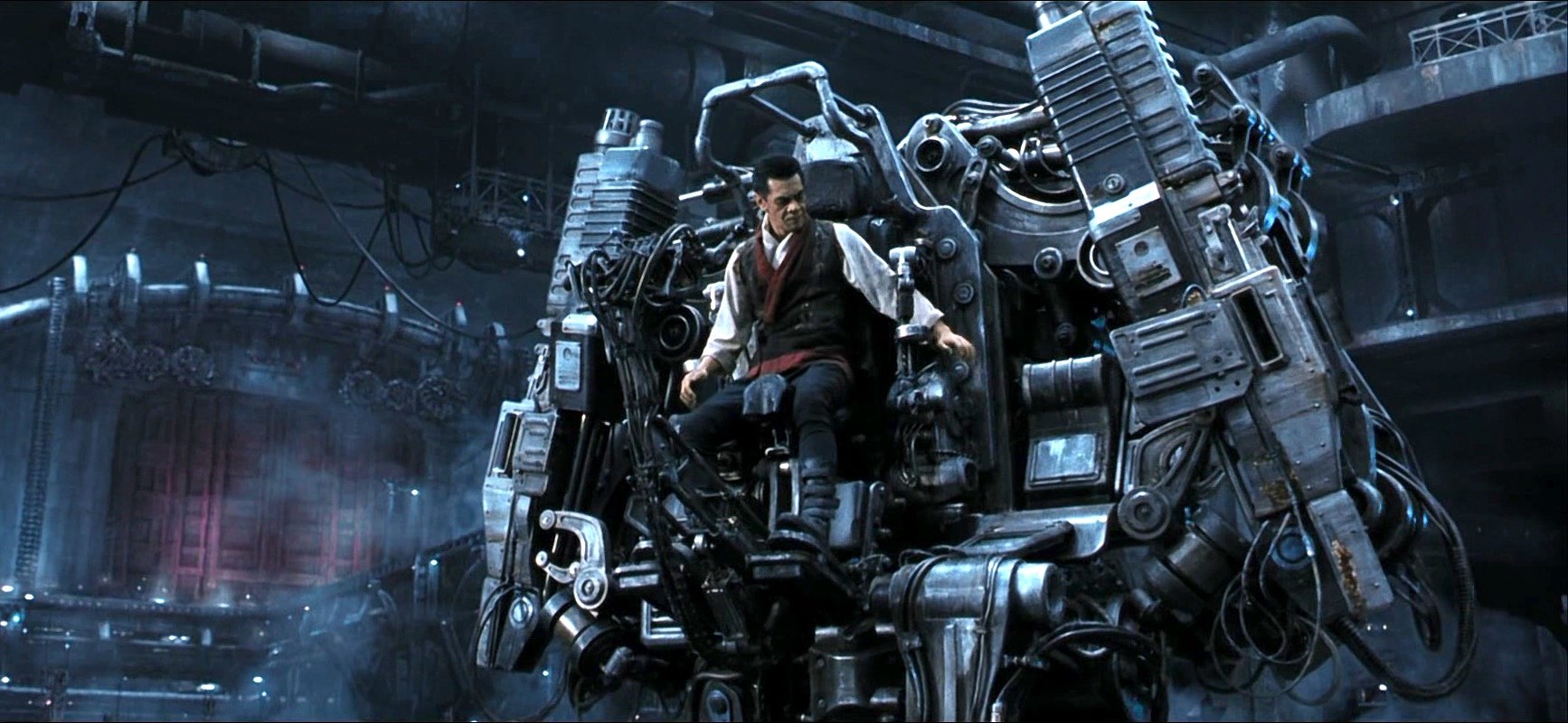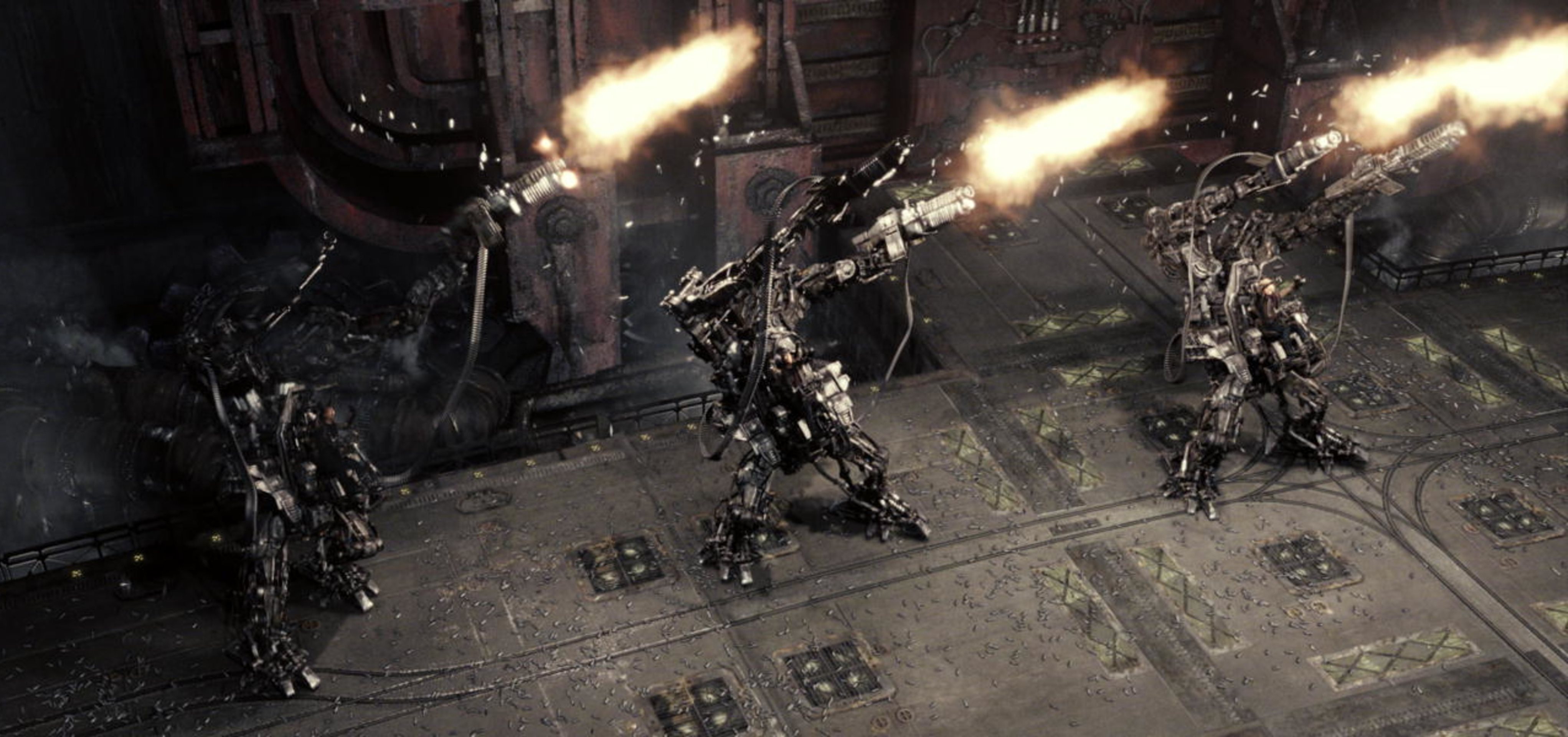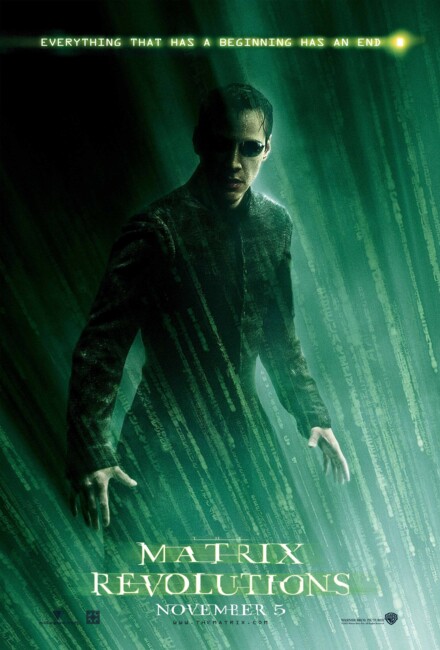USA/Australia. 2003.
Crew
Directors/Screenplay – The Wachowski Brothers, Producer – Joel Silver, Photography – Bill Pope, Music – Don Davis, Visual Effects Supervisor – John Gaeta, Visual Effects – Buf Compagnie (Supervisor – Stephanie Ceretti), CIS Hollywood, ECC Entertainment, Giant Killer Robots, Pacific Title and Digital, Pixel Liberation Front, Sony Pictures Imageworks & Tippett Studio (Supervisor – Craig Hayes), Special Effects Supervisor – Steve Courtley, Production Design – Owen Paterson, Conceptual Design – Geoff Darrow, Fight Choreography – Yuen Wo Ping. Production Company – Warner Bros/Village Roadshow/NPV Entertainment/Silver Pictures.
Cast
Keanu Reeves (Thomas ‘Neo’ Anderson), Carrie-Ann Moss (Trinity), Laurence Fishburne (Morpheus), Hugo Weaving (Agent Smith), Mary Alice (The Oracle), Jada Pinkett Smith (Captain Niobe), Harry Lennix (Commander Jason Lock), David Roberts (Captain Roland), Clayton Watson (The Kid), Nona Gaye (Zee), Ian Bliss (Bane), Nathaniel Lees (Captain Mifune), Lambert Wilson (The Merovingian), Tanveer Atwal (Sati), Bruce Spence (The Trainman), Collin Chou (Seraph), Harold Perrineau Jr (Link), Bernard White (Rama-Kandra), Essie Davis (Maggie), Helmut Bakaitis (The Architect), Anthony Zerbe (Councillor Hamann)
Plot
Trinity and Morpheus set out to rescue Neo who is trapped in a railway station controlled by The Merovingian that exists between worlds. They then race to get back to Zion before the advance wave of the machines arrives. Using armoured power lifters, the people of Zion fight a desperate defence against the tide of AI drones. Meanwhile, Neo, following the guidance of The Oracle, makes an almost-certainly suicidal decision to travel to Machine City, the home of the AIs. There, in a tenuous truce with the AIs, he enters the Matrix to engage in a duel to the death with Agent Smith who had gone rogue and is threatening to bring the entire Matrix down.
The Matrix (1999) was one of the genuine genre landmarks of the last decade. It was a film that both conceptually and stylistically redefined science-fiction cinema – it opened up the Virtual Reality concept with breathtaking regard, it toyed with genuinely mind-expanding concepts about all of reality being a simulation, and offered revolutionary action stylistics and special effects techniques that have since been much copied. It became what one might call a mainstream cult film. The Matrix phenomenon, in terms of its mass popularity and cultish fan following and its redefinition of the science-fiction genre, might well be compared to the effect that Star Wars (1977) had when it first came out.
And, as George Lucas did, The Wachowski Brothers returned to expand the original offering into a trilogy. 2003 was, as the advertising informed us, “The Year of the Matrix”, wherein The Wachowski Brothers shot one massive-size film and released it in two parts six months apart. The Matrix Reloaded (2003) was the first of the sequels and The Matrix Revolutions was the third and concluding instalment, while the Wachowski Brothers also oversaw The Animatrix (2003), a collection of animated shorts set in and around the Matrix universe. Several years later, Larry/Lana Wachowski returned to direct/co-write The Matrix Resurrections (2021).
Only, for all the cult appeal that The Matrix found, The Matrix Reloaded met with very mixed response. Dismissed variously as dull, incomplete and incomprehensible in the Wachowski Brothers ponderings about fate and predestination, and with its love scene even being somewhat ignominiously nominated by Empire magazine as one of the Top 10 biggest turnoffs of all time, The Matrix Reloaded found only cautious admirers and few in the way of ecstatic rave reviews. Likewise, The Matrix Revolutions opened to continuing disappointment, with an almost universally indifferent worldwide critical reception.

To continue the Star Wars analogies above, The Matrix Revolutions could almost be the Matrix trilogy’s Return of the Jedi (1983). It is the concluding chapter of the series, it is also the weakest chapter and it contains many of the same problems that Jedi had – the sidelining of the central characters (in particular Morpheus) in favour of big special effects sequences. Indeed, there are even a number of story similarities between The Matrix Revolutions and Jedi – the opening act that involves the rescue of the hero; the hero having to venture single-handedly into the enemy’s realm to confront his evil shadow half; and of course the big central special effects set-piece of the film – the defence of the dock – which makes one think of the Death Star attack in Jedi restaged as a Transformer battle.
All of that said, The Matrix Revolutions works better than Jedi does. The Wachowski Brothers have not lost the plot in the same way that George Lucas did with Jedi and his second Star Wars trilogy – Star Wars Episode I: The Phantom Menace (1999), Star Wars Episode II: Attack of the Clones (2002) and Star Wars Episode III: Revenge of the Sith (2005), which turned the series into little more than a big-screen Playstation game with characterization reduced to purple prose that seemed barely to resemble anything that could ever be uttered by human beings.
The Matrix had a breathtakingly cool ingenuity to its concept – the whole world is a virtual illusion, one can become its master by manipulating the program with the promise of a titanic struggle between a small coterie of free people fighting to liberate the rest of humanity from enslavement to the machines. By contrast, the most frustrating thing after seeing The Matrix Reloaded and The Matrix Revolutions is that one is in far more confusion about the metaphor and the nature of reality/illusion than before one sat down to watch either film. The purpose of either sequel should have been simple – to end the promised war between humans and machines, to allow Neo to fulfil his predestiny and perhaps to explain how the Matrix came to be.
However, the two sequels do not do any of this. For one, the war is not ended – there is a showdown between Neo and Agent Smith but the Matrix illusion is still in place at the end of the film. (While the first film seem to indicate humanity being trapped in a virtual illusion was a bad thing, The Matrix Revolutions seems to end on a restoration of the status quo – the machines are still in control, humanity is still in the virtual illusion and being used as cattle to power the machines but an ambiguous peace has perhaps been achieved and the perpetual subterranean green-lit look has been replaced by a cautiously optimistic sunrise). Elsewhere, Neo fulfils some murky predestined acts but quite what happens to him at the end of the film is baffling.

The Matrix Reloaded disappointed a good many fans in the Wachowski Brothers venturing off into philosophical ruminations about the nature of predestination, free will and fate. While this was not entirely uninteresting, they stretched the metaphor of Matrix illusion by introducing a good many other concepts – The Architect, The Merovingian, The Keymaker, backdoors into the program, a rogue Agent Smith, questions about The Oracle, the idea that the entire scenario had been replayed six times before – that muddied the original idea. It was surely The Matrix Revolutions‘s duty to clear this up and explain everything.
Alas it doesn’t, it leaves a host of questions still hanging – we are still no clearer on who The Architect is; as to how come the simulation has been rerun before; how The Oracle can predict things (or indeed why she is being punished for her actions); or how come Agent Smith has gone rogue – while leaving us with an entire set of new questions – what and where is the railway station that turns up at the start of the film? how can a virtual program (Agent Smith) possess people in the real world? or how come Keanu Reeves manages to have superpowers that exist in the real world now as opposed to the ones he had that only existed within the virtual realm of the Matrix?
It is possible that there are clear answers to these questions embedded somewhere in the two sequels but I would defy anyone who has seen either film only once to come up with a coherent explanation. If that is the case then the Wachowski Brothers have created a duo of films where they have failed to adequately key audiences in on the complexity of the concepts that are running through their heads. You are not entirely sure if it is a case where they have simply acted in disdain at the thought of offering up the usual watered-down explain-all-to-a-moron low concepts that Hollywood science-fiction operates by, or simply that they are operating on such a plane removed from mere mortals that they had difficulty explaining the ideas that were more than evident to them.

The Matrix Revolutions is a frustrating end to the trilogy. Yet while the film leaves the series high concepts as an untidy accumulation of loose ends, The Matrix Revolutions not entirely a loss. Where it does work particularly well is in the action department. The Wachowski Brothers have set out to create some genuinely spectacular special effects sequences and in this regard The Matrix Revolutions is the most stunning film of the trilogy. For a time you almost think it isn’t going to be – the first hour passes by with only a single action sequence, a routine shootout between Carrie-Ann Moss, Laurence Fishburne and a group of guards who have the slightly interesting, albeit gimmicky, ability to walk along the ceiling.
Then however the Wachowski Brothers offer up the dock siege sequence and immediately such misgivings are laid to rest. The sequence is justifiably the jewel of the two sequels and has been extended for nearly 30 minutes and comes filled with breathtaking sequences with humans wading into action in Transformer robots to fighting off invading masses of AI drones, seat-edge feats of heroism trying to fire rockets into the maw of giant drill weapons and open the door in a downed power loader, and a race through the mechanical conduit. The Wachowski Brothers have surpassed themselves here and the sequence is stunning. Slightly lesser in comparison but nevertheless excellent is a superpowered battle between Neo and Agent Smith in the rain, filled with swoops and dives across the sky and power punches that demolish entire city blocks and blast rain like nuclear detonations. In these two sequences, the feeling there was in The Matrix Reloaded of the action sequences seeming contrived and filled with technical wizardry for its own sake is gone – they stun.
It is here, rather than any of the things that made the other films work such as the concepts and philosophical meditations, that The Matrix Revolutions succeeds. That leaves it an odd mixture of disappointment and praise – praise because the Wachowski Brothers do the effects sequence on such a spectacular scale, disappointment because the only level the film works on is in having to forget about the conceptual pleasures of the other films and in simply sitting back and enjoying the special effects display. And that ever so disappointingly makes The Matrix Revolutions only one step above George Lucas’s second Star Wars trilogy in that the only reason that the film works is merely in that the Wachowski Brothers succeed in outdoing Lucas in the spectacular amazement of their effects sequences.
(Winner for Best Special Effects, Nominee for Best Musical Score at this site’s Best of 2003 Awards. No. 9 on the SF, Horror & Fantasy Box-Office Top 10 of 2003 list).
Trailer here


